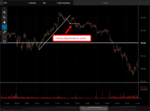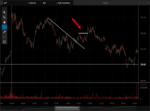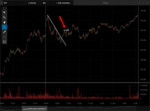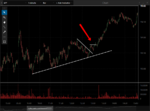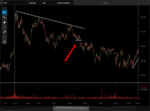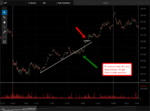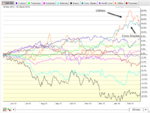Determining the trend
Wyckoff approach.
Weekly.
From the 15 of December we are in a trading range. I haven't seen any whooping up maneuvers before this trading range. Only minor climax moves, the lows of which are on 13th of October 2014 and 24 of August 2015. As I see it, price can't go lower 181 level, each time price has been meeting enough buying to reverse. Volume was high, but there were no result on the downside (no follow through). Last time price were unable to equal previous high level. That indication should be regarded as one of the potential signs of supply. Anyway, price is in a range, from this point of view I should be in a neutral position.
 Daily.
Daily.
From the 30th of December till 20th of January market has declined sharply. Price has met previous support with signs of Selling climax. This selling climax has less volume if it will be compared with previous climax. Then I see two attempts to test this Selling climax. First test occurred from 25-28 of January, where we see TR out of which price went higher. After meeting supply from previous rally top, price declines. The second test has occurred on the 8th of Feb. During decline volume were not increasing. There is less volume on ST. Next day price rallies, which is the first sign of a bullish behavior. On the 10th we see higher top and higher bottom. On the 11th situation is a little bit critical for me. Price went lower, but it hasn't went lower than previous support, volume has raised and with increased volume on this day, price were unable to push lower. Next day price goes higher and approach supply line from the 4th of Feb. For me this situation is still critical. As I don't see signs that this small leg down has ended or has been exhausted. The best place to go higher - yes, that is the best place, as we have price risk at a minimum. To be sure that this market is more probable will go higher from this place - no, confirmation or any worthwhile sign of demand hasn't occurred for me still. On the 16 we see that downward stride is broken.This is confirmation, that secondary test has been exhausted and we more probably will see more rally. From this point, I see, that we have seen signs of SC and secondary test (successful as price went higher) and I can say that we are probably in an uptrend which should be confirmed by ability to rise higher than previous rally. From 12 till 17 we see rally on decreasing volume, I guess it is due to scarcity of supply at this level. Though I don't understand fully what scarcity means (that's more likely one of the signs of bullish behavior, which increase our level of confidence) and how I can benefit from this situation. What I see, is that price has raised from the lows after the test (if price is rising, then demand is greater than supply, at least at this level.) From 18 until the present I see, that price is struggling to go higher at a point where previous rally has met supply, though it goes. Price has confirmed that we are in an uptrend. So positions must be on the long side.
That was an effort to tell a story from the Wyckoff point of view, as he did it.
 SLA approach.
Weekly
SLA approach.
Weekly
After the brake of Demand line, price hasn't made confirmed retracement. It is better to say that price is in a TR, so, no SLA approach will work here.
 Daily.
Daily.
From the Straight Line Approach method, we are in an uptrend, since demand line still is not broken and price goes higher. I will pay attention on the nearest level 200. As this represent top of a previous Trading range. At this place reaction can be expected. By this reaction we can judge what market will do next. For now price is rising to 200.

I am not a professional on Wyckoff approach (but I am desire to be). SLA approach tells me, that weare in an uptrend, so trades must be on the long side.
P.S.: I was thinking about my thoughts and my knowledge about Wyckoff approach. May be I choose questions which are not of any help at this or those situations. I mean , I look for answers where this answers won't give me any important information.
What kind of questions should I ask, when price declining, rising. stand still?
 ) will help me to improve my mistakes.
) will help me to improve my mistakes.
